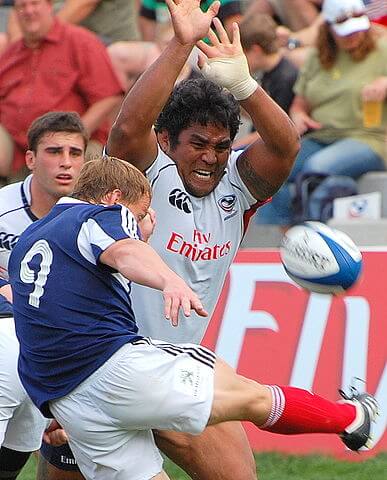Can you block in rugby as players can in American Football? Rugby Union has several laws that prohibit blocking or running interference. Blocking is a penalty offense.
However, the laws also allow onside players to hold their position or running line. In other words, players don’t have to get out of the way of their opponents.
This leads to some gray areas when referees must make a judgment on whether blocking occurred.
This article shows you three examples where the blocking or interference was subtle. You’ll see that it’s a tough job to be a rugby referee!
Blocking In American Football Compared To Rugby

Blocking is a huge part of American Football, where it is given the name of running interference.
Although some positions are on the pitch almost solely to block (e.g. offensive linemen), most players may be called on to block for their teammates at some point in a game.
Rugby fans may think that blocking is unlimited in Football, but there are strict restrictions on what the blockers can do.
Footballers can’t full-on tackle an opponent without the ball, but they can use far more physical interaction than in rugby.
American Footballers can swerve into the path of opponents without the ball. This is not allowed in rugby but can be a gray area. We’ll look into the do’s and don’ts in detail in this article.
Footballers can push opponents who aren’t the ball carrier (without grasping or grappling them).
This is far less of a gray area in rugby as the action is so obvious. It will be a penalty kick against the blocker.
Can You Block In Rugby? Running Interference
Here’s an exciting scenario: your winger is haring down the touchline with the ball, and you’re sprinting like crazy in support.
A defender is racing beside you trying to catch up and tackle your teammate. What do you do?
Take a look at this clip from the All Blacks vs Australia in 2016.
Speight is the Wallaby heading for the line, and Savea is trying to chase him down. Wallaby Haylett-Petty is the Aussie on the heels of his teammate. See how it pans out!
What does the rulebook say?
This is the relevant rugby law:
When a player and an opponent are running for the ball, neither player may charge or push the other except shoulder-to-shoulder.
That means that you can’t grapple with your opponent with your arm outstretched. Nor can you run across them. So, how do you think the referee called it?
What happened
The referee adjudicates that the Australian player impedes the All Black defender from making the tackle.
Blocking is illegal, so the try is ruled out and a penalty kick was awarded to New Zealand where the blocking incident occurred.
Why it was contentious
There was a lot of debate after the match about the decision.
Some of the Australian commentators were demanding that the referee (the highly-respected Nigel Owens) be banned from rugby. To be fair, that was Rod Kafer who is notoriously excitable.
The truth is that another referee may have made a different decision. I’ve seen plenty of tries being awarded when a teammate ran very close, even shoulder-to-shoulder, to the chasing tackler.
The key is whether the teammate changed the angle of his run to interfere with the would-be tackler.
You are allowed to run straight toward the try line. The most subtle play is not to allow the slightest of interference to be noticed! Haylett-Petty simply wasn’t subtle enough.
Ironically, I doubt that Savea (the All Black) would have had the legs to chase down Harry Speight. If Haylett-Petty had kept his nose clean, the try would have been safely awarded.
Can You Block In Rugby? Subtle Shielding
You can run in support of your teammate, and you don’t have to get out of the way of the opposition. You can also slow down or stop dead in your tracks if you feel like it.
If that stops a would-be tackler who is running laterally, then hard beans to the opposition.
A history-making example of successful blocking
In 2016, Ireland went to Chicago to play the mighty All Blacks.
In their long 111-year history in the game, Ireland had never beaten New Zealand. Ireland ran up a great score but saw their lead whittled down to 33-29 toward the end of the match.
You’d tend to bet on the All Blacks in that situation. And they’d beaten Ireland in similar circumstances the last time the teams met in Dublin.
But Ireland scored a try in the final minutes from a scrum. With the most beautiful example of subtle blocking you’ll ever lay eyes on.
I’ll admit I’m biased here in favor of green! I was close to tears at the result.
Here’s the play in the final minutes.
What happened
Ireland 8, Jamie Heaslip, breaks from the back of the scrum. This is a planned move from coach Joe Schmidt, a technical master of the game.
Heaslip pops a reverse pass to his inside center, Robbie Henshaw.
The New Zealand backs are running laterally to tackle the center bursting toward the line. The number eight no longer has the ball but he’s entitled to continue to run in the direction he was going when he gave the pass.
A few steps take him into the path of the covering defenders. Then Heaslip stops dead.
Watch him brace for impact, but the defenders are so interested in making the tackle that they manage to slip by him. The key is the half-second delay that Heaslip has made.
Small margins
There was no real contact, and the try was awarded without much quibbling from anyone.
But what if one of the All Black defenders had bumped into his opponent and waved his arms in protest? This is pretty much what Savea did in the previous clip (I’m talking about the waving). The referees may have taken a closer look.
I’ve watched Heaslip throughout his playing career with Leinster and Ireland. He was a master at this subtle shepherding of teammates who got the glory!
Shepharding The Ball Over The Line
I’m going to show you an example where a penalty was given after an incident of blocking. But this time, the player being blocked was the guy who was penalized!
This scenario shows a player shepherding a ball that they hope will roll out of play.
It’s a risky tactic, due to the unpredictable nature of a rugby ball. If the ball stops dead before touching the line, the opposition player could hack it forward.
Here’s the clip. England is playing Scotland in the 2016 Six Nations.
What happens
England captain Owen Farrell chases a kick forward by his teammate. Scottish captain Greig Laidlaw races across to meet the ball.
Laidlaw, in blue, desperately wants the ball to go out of play without having to touch it. He slows right down but doesn’t change direction.
He simply uses his body to block the path of the England player in white.
The frustrated England player gives his opposing captain a good shove in the back. In rugby, you can’t push a player without the ball.
What does the law say?
Rule 10.1 is pretty clearly written, although not always so clear to judge.
A player must not intentionally move or stand in a position that prevents an opponent from playing the ball.
World Rugby Laws
The outcome
In this case, the player blocking the ball is judged to be legal. It’s a gray area, but players in an onside position are not required to jump out of the way to allow opponents to play the ball.
And the player trying to get at the ball is penalized. Because you can’t barge your way through a player holding his line!
Plenty of referees would have shrugged, and maybe given the England player a talking-to.
I don’t remember too much about the match, but I’ll assume there’s been some fractious play at some point beforehand. Owen Farrell has a reputation for arguing with referees.
Legal Blocking In Rugby: Rucks And Mauls
Rucks and mauls are a special case of legal blocking.
A maul occurs when a tackle is made but the tackled player does not go to ground. Teammates bind to the ball carrier and drive forward, while the opposition attempt to stop their progress.
You often can’t see the ball in a maul! This is because the carrier is surrounded by teammates, some who are in front of the ball.
I’m not going to try to explain all the nuances in this article! Suffice it to say, some blocking is legal. But some blocking in mauls is not!
What about rucks, when the scrum-half getting ready to box-kick the ball away?

You’ll often see the yappy little nines yell and point at their tallest forwards before they crouch to pick up the ball. They want their teammates to stand at the side of the ruck and block the opposition players from charging down their kicks.
If you’re not sure what I’m talking about, I go into charge downs in detail in this article on circumstances where you can block a kick in rugby in open play.
I’ll just mention here that the scrumhalf’s teammates are entitled to position themselves alongside the ruck and hold that position. They can’t jump laterally into the diagonal path of an opponent, but they don’t have to get out of the way.